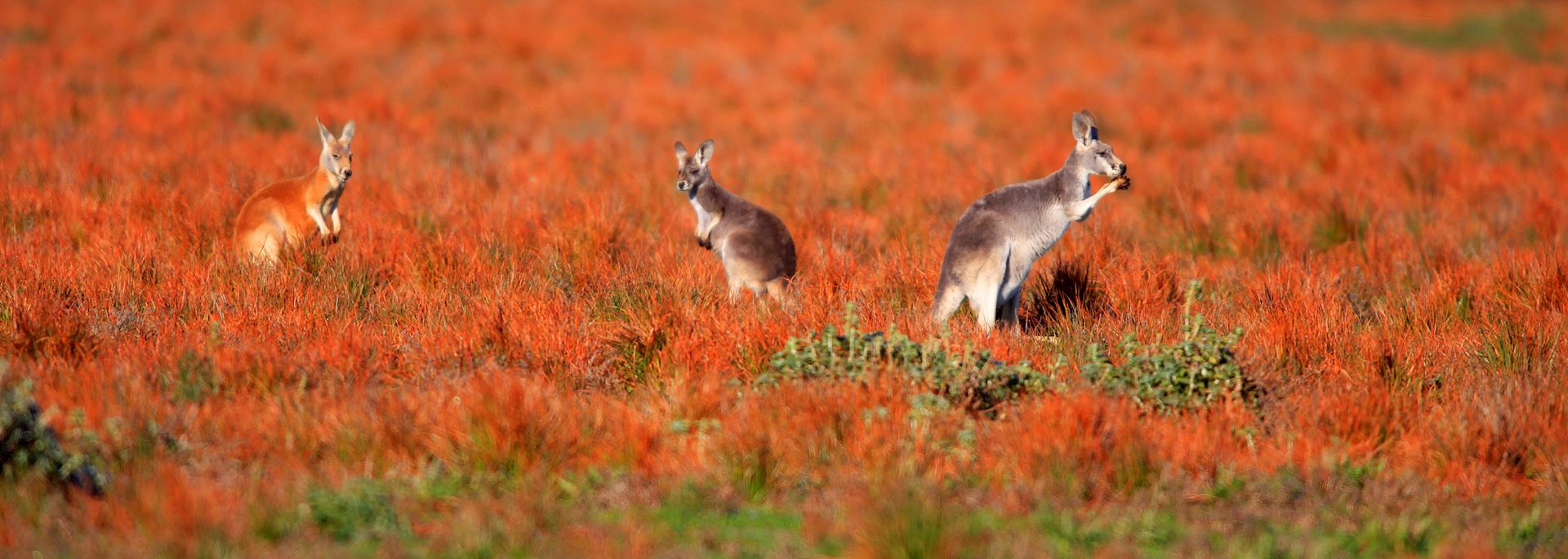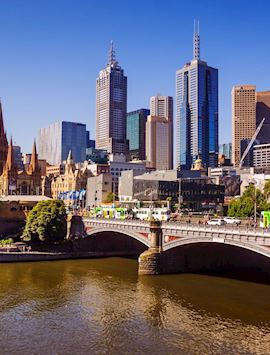By Australia specialist Tom
South Australia has two main areas when it comes to standout scenery — both mountainous and littoral — and intimate wildlife experiences.
There’s Kangaroo Island, a short flight from Adelaide, and Flinders Ranges, a stretch of bonafide Outback that lies barely a six-hour drive north of the region’s hub city (in contrast, you’d need to fly for three and a half hours to reach Uluru and the Red Centre).
This is one of the things we love about this little-trodden part of the country: the urban teeters on the edge of vast, untamable wilderness. You could easily incorporate visits to both places over the course of a two-week trip to the country, spending two or three days in each.

South Australia guide
Shining a spotlight on South Australia
Kangaroo Island
Within its wave-lashed borders, Australia’s third-largest island replicates many of the environments of the mainland, from mallee scrub to beaches to fertile farming territory. It’s truly like a micro-Australia.
With a large swathe of the island, which lies some 112 km (70 miles) off the coast of Adelaide, now a protected South Australian national park, it also acts as a natural sanctuary for the wildlife species that have helped put Australia on the naturalist’s map. For wildlife lovers, there’s really no better place in Australia to go, in my opinion.
The landscapes of Kangaroo Island
Topographically, the island has a bewitching split personality. The northeast is all calm, sheltered bays and sandy, almost tropical-looking beaches with the odd shack serving fresh King George whiting. Conversely, I always think the southwest of the island seems completely unravaged by the hand of time or man. It still looks exactly as it would have to the first 19th-century explorers. Meanwhile, the forested interior of the island is far quieter. Driving along its dirt roads, you can almost kid yourself you’re in the Outback.
On the west side of Kangaroo Island, you’ll find the Flinders Chase National Park (not to be confused with the Flinders Ranges back on the mainland that I tell you all about below.) High limestone cliffs protect the coastal heathland from the swells of the icy Southern Ocean, and strong winds pummel the scrub.
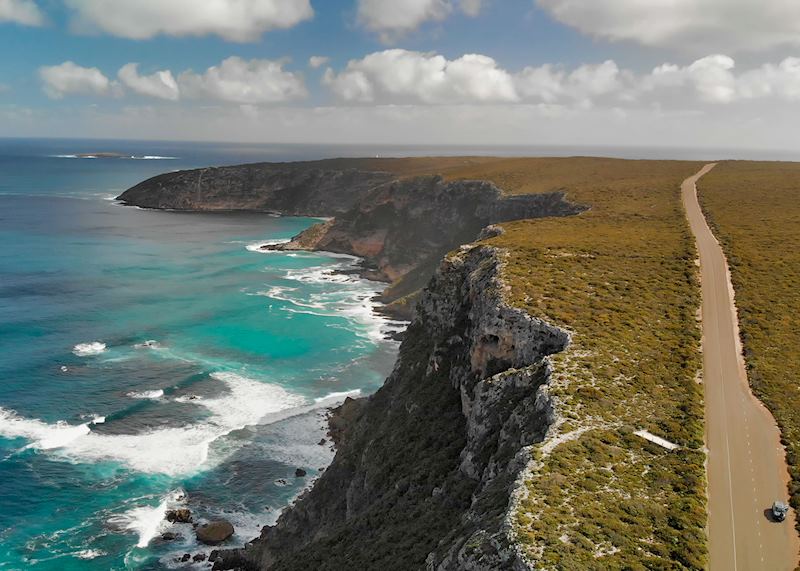
Here, the weathered granite boulders known as the Remarkables crown a lava dome, their sides spotted with glaringly orange lichens. There’s a great short hike that runs from these rocks down a winding boardwalk to a natural formation, Admirals Arch. Expect to be buffeted by the wind and spray from the ocean waves.
Many parts of the island are wonderfully dark. The kind of deep, velvety darkness that’s rarely encountered in most areas of the developed world. I’ve heard stories of visitors from New York City being utterly bewildered by such total night. I’d make time for a little stargazing, especially if you’re unfamiliar with the Southern Hemisphere sky. There’s very little light pollution on Kangaroo Island, and most of the best places to stay are in remote locations, so the night sky is astonishingly clear. The Southern Cross constellation is the main event, but there are also lots of nebulae and star clusters to admire as well.
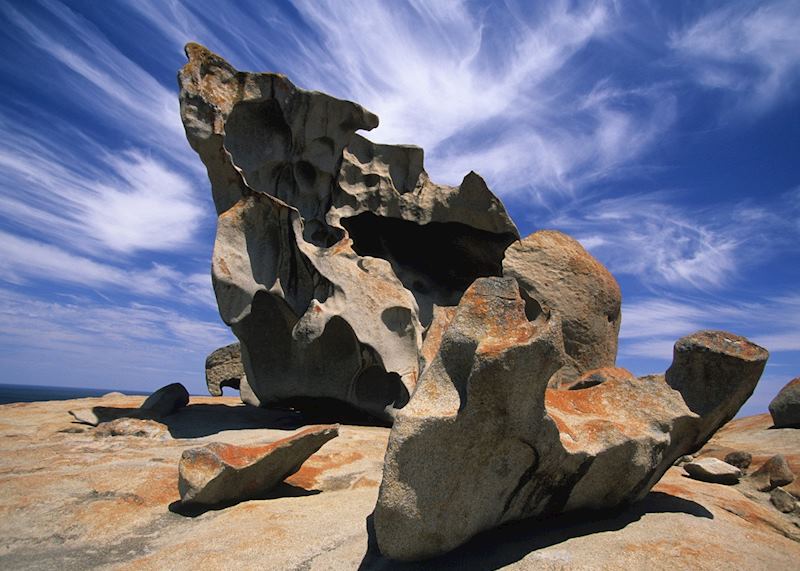
Wildlife on Kangaroo Island
When explorer Matthew Flinders set foot here in 1802, he discovered a place absent of predators and with no signs of aboriginal presence, where the wildlife ran rampant. Even now, the kangaroos are brazenly curious and will come bouncing right up to you. Koalas, too, have got so comfortable here, their population has exploded. I was thrilled to see one slouching along on all fours, rather than dozing in a gum tree (their modus operandi).
Rosenberg’s goannas — a type of monitor lizard — are also commonly seen. Having no predators, they often emerge out of the underbrush in broad daylight. Wallabies are slightly shyer, and can startle at sudden movements around them.
Out at sea, you can sometimes see southern right whales basking with their calves in the north coasts’ coves. Look for them blow holing, an easier task on this side of the island since the water isn’t the white-tipped, roiling mass it is on the south coast. Meanwhile, in a lagoon near American Beach, you’ll see hordes of jabbering pelicans.
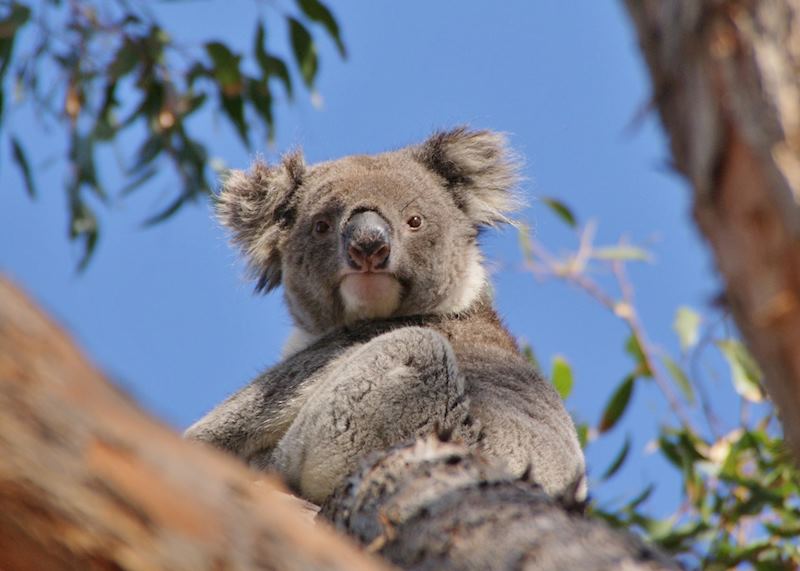
The glossy black cockatoo, a Kangaroo Island success story
It was while staying at Kangaroo Island Lodge that I caught a movement in the she-oaks around the property. My guide hushed me and pointed. There was a squawky call from the trees, and then, as I watched, five birds came swooping over our heads, making for their roosts in hollows of the surrounding gums. It was the glossy black cockatoo, which are endemic to Australia.
Some had yellow speckles around their inky-black head plumage, and they all had scarlet tail feathers (the females have three scarlet stripes). We watched them nibble on the cones of the she-oaks with their large, stubby bills. The property had, I learned, planted these trees especially in the hope of luring these incredibly rare (and notoriously fussy) birds.
Glossy black cockatoos are extinct on Australia’s mainland, partly due to possums who eat their eggs, and partly because they’ll only roost in and feed on certain types of tree. But they’re gradually making a comeback on Kangaroo Island. If you’re an enthusiastic birdwatcher, I’d highly recommend you take a tour with a guide who’s expert in the glossy black cockatoo to increase your chances of seeing them.
In search of echidnas
Officially ‘spiny anteaters’, echidnas resemble a giant trundling horse chestnut with a long beady snout (technically a beak) and a forked tongue that’s all the better for slurping up ants. It also helps them sense vibrations in the earth, which is another reason they can be hard to find: they can usually hear you coming. The young — called puggles — are born bald. Kangaroo Island happens to be a particularly good place to spot these creatures.
Surprisingly, you might see them, as I did, on the dirt roads — the road surfaces attract ants, and thus echidnas. I’ve also heard colleagues’ stories of searching everywhere for them to no avail, only to practically trip over one enjoying its evening meal in the garden of their B&B. Perhaps your best chance of seeing one is in fields, with a naturalist guide who’s adept at identifying their tracks.
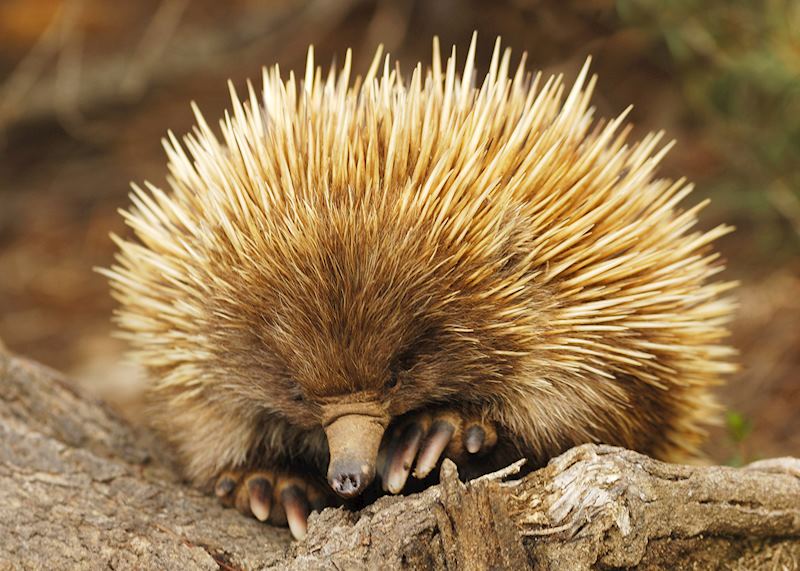
Where to stay on Kangaroo Island
Providence Guest House, a B&B that’s designed to evoke a Tuscan villa, is my first choice. It sits amid farmland overlooking Smith Bay, and has access to its own private beach. Inside, it has a congenial, home-from-home feel: it’s the kind of place where you might sit down with other guests to chat over a glass of wine before dinner. I especially like the ‘balcony room’ with views over grasslands and the inlet of the Gulf Saint Vincent.
Getting to Kangaroo Island
Direct flights from Adelaide (35 minutes) operate to Kingscote, the island’s main airport. From here, you can rent a car to explore the island’s national parks, but given that many of the roads are unsealed, it can be easier to let someone else do the driving and embark on private touring.
Ikara-Flinders Ranges National Park
Flinders Ranges was a bit of a revelation for me. I’d always assumed that getting away from urban Australia required a plane journey. But Flinders offers that quintessential, uncrowded Outback experience in relatively close proximity to a major city.
In the Austral summer (October to February), the land here is a Martian shade of red — ‘sunburnt country’ in the words of Australian poet Dorothea Mackellar. In wintertime (June to September), the land is — perhaps unexpectedly — lustrously green, and scattered with clumps of white olearia daisies, among other wildflowers.
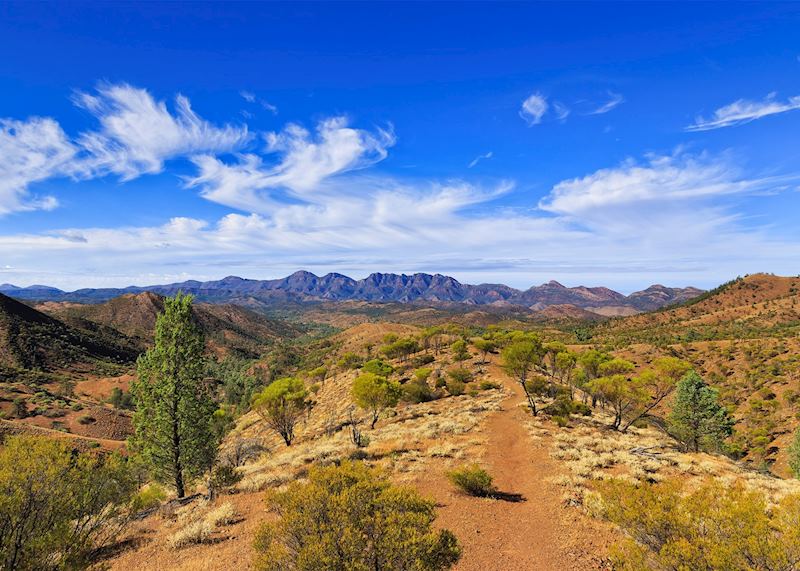
The landscapes of Flinders Ranges
Okay, so there’s no Uluru (Ayers Rock), but there’s still a monumental natural formation to gape at: Wilpena Pound. A vast geological bowl seemingly hewed out of the earth, with only one entranceway (hence the name ‘pound’), it’s sometimes mistaken for a meteorite crater, but was actually caused by synclines in sedimentary rock.
At 8 km (5 miles) wide, Wilpena Pound is latticed with walking trails, but its scale is difficult to take in at ground level: it’s better witnessed from the air on a scenic flight. I think it looks even more prehistoric when you look down on it from up high.
From the air, you might also spy the remnants of the area’s copper mines (mostly used between 1862 and 1908), which the dry climate has helped to preserve. Despite seeing the odd desiccated abandoned homestead, there’s a sense that the pioneer lifestyle is alive and well, too. Old wool-shearing machinery hangs in the restaurant at Rawnsley Park Station, where I stayed, and the Prairie Hotel proudly serves a ‘feral mixed grill’. The menu? Kangaroo, emu and camel sliders. You might also like to swing by this hotel on Friday mornings or Sunday afternoons for a drink on its veranda. At those times, guests traditionally wave to the Ghan train as it zooms past on its way to or from the deepest Outback.

Leaving the Clare, the vines segue into farmland, then grassland, and finally desert scrubland. The vestiges of civilization and human development peter out, and soon you’re alone on the road, the only other signs of life the kangaroos and emus who occasionally lollop along by the asphalt. You’ll pass the railway town of Quorn, a tumbleweed-blown outpost that has the feel of being the last frontier before entering the wilds.
Soon the Flinders Ranges, the largest mountain range in South Australia, begins to shimmer on the horizon. It’s the eroded remains of a huge geosyncline, and you can see how the rocks (a mixture of quartzite, limestone, shale and sandstone) have been faulted and folded.
As you near the Ranges’ foothills, you might pass the stone skeleton of a former homestead, Kanyaka. Farther into the national park, you’ll come across more and more of these dust-laden, abandoned homesteads and former sheep stations.
Experiencing ‘the Flinders'
Flinders Ranges was a bit of a revelation for me. I’d always assumed that getting away from urban Australia required a plane journey. But Flinders offers that quintessential, uncrowded Outback experience in relatively close proximity to a major city.
In the Austral summer (October to February), the land here is a Martian shade of red — ‘sunburnt country’ in the words of Australian poet Dorothea Mackellar. In wintertime (June to September), the land is — perhaps unexpectedly — lustrously green, and scattered with clumps of white olearia daisies, among other wildflowers.
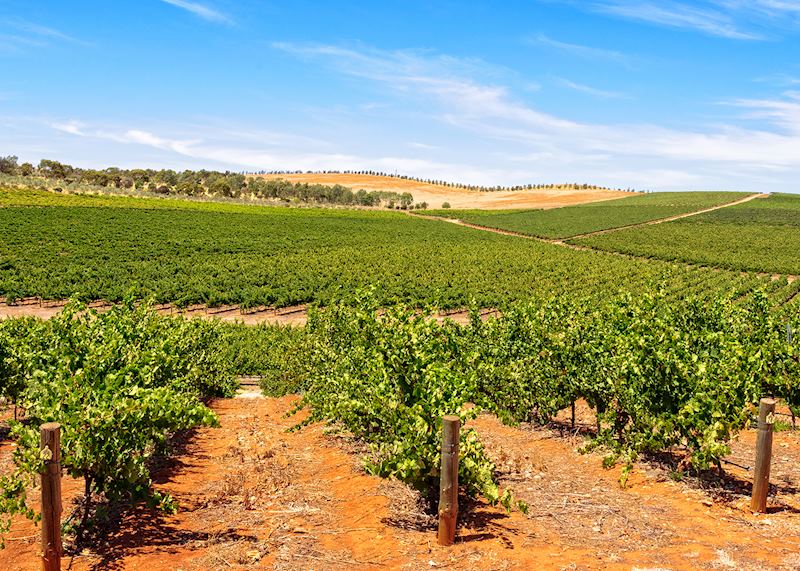
Driving to Ikara-Flinders Ranges National Park
From Adelaide, it’s a five- or six-hour drive to the mountains known as the Flinders Ranges. To break up the journey, I suggest stopping off (even for a night) in the Clare Valley vineyards, which lie roughly halfway between the city and the Outback.
They may be frequently overshadowed by the larger, ritzier Barossa Valley to the south, but they’re celebrated for their riesling. This in turn has given rise to the Riesling Trail, some 23 km (15 miles) of disused railway that has been turned into a cycling path and hiking trail; it’s also suitable for wheelchairs.
You can journey its length, sections of which are bordered by shady pines and purple scabiosas, stopping off at cellar doors to sample their aromatic whites. The wineries here range from tiny boutique places to Sevenhill Cellars, a winery founded by Jesuits in 1851 for the production of sacramental wines.
Leaving the Clare, the vines segue into farmland, then grassland, and finally desert scrubland. The vestiges of civilization and human development peter out, and soon you’re alone on the road, the only other signs of life the kangaroos and emus who occasionally lollop along by the asphalt. You’ll pass the railway town of Quorn, a tumbleweed-blown outpost that has the feel of being the last frontier before entering the wilds.
Soon the Flinders Ranges, the largest mountain range in South Australia, begins to shimmer on the horizon. It’s the eroded remains of a huge geosyncline, and you can see how the rocks (a mixture of quartzite, limestone, shale and sandstone) have been faulted and folded.
As you near the Ranges’ foothills, you might pass the stone skeleton of a former homestead, Kanyaka. Farther into the national park, you’ll come across more and more of these dust-laden, abandoned homesteads and former sheep stations.
From the wild coastlines of Kangaroo Island to the rusty red hills of Flinders Ranges, these South Australia destinations should definitely be on your must-visit list.
Start planning your trip to South Australia
Start thinking about your experience. These itineraries are simply suggestions for how you could enjoy some of the same experiences as our specialists. They're just for inspiration, because your trip will be created around your particular tastes.
View All Tours in Australia